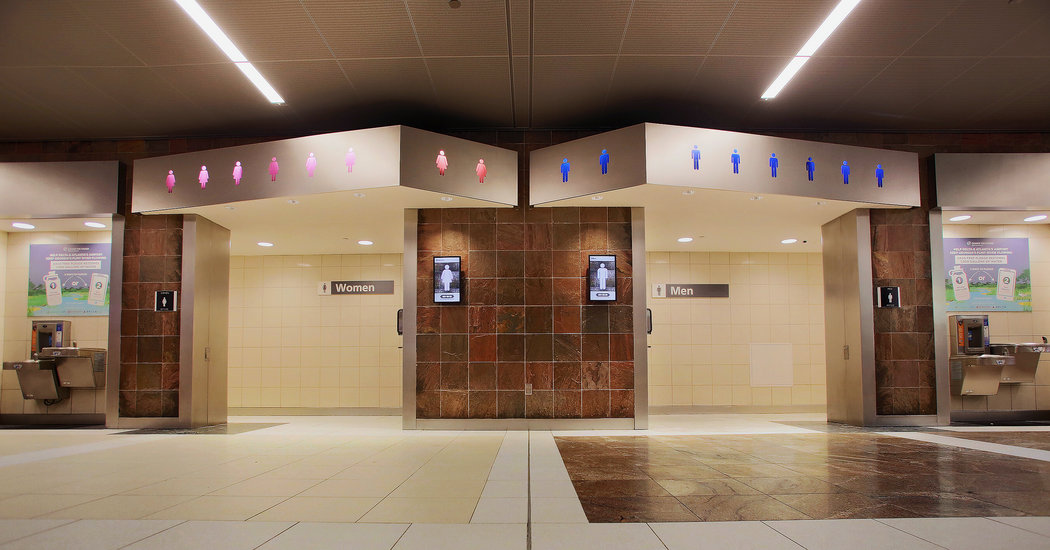
As airlines continue to shrink the size of their in-flight bathrooms, to make room for more seats in economy, making them all but unusable for tall and overweight passengers, more fliers may increasingly be seeking comfort in places they once avoided at all costs: airport restrooms.
Those dingy, unappealing spaces — often with broken door latches, paper towel dispensers that have long ago run out of towels, and floors that look they like they are in dire need of cleaning — have often been the option of last resort for many frequent travelers.
But, now, increasing numbers of airports seem to have recognized that clean bathrooms are an important aspect of travel and have begun to take steps to improve both the conditions and the monitoring of their facilities.
“Bathroom cleanliness is a big driver of satisfaction at airports, and if you want a pleasant experience, clean bathrooms are a must,” said Dimitri Coll, the associate director for the Airports Council International, the official association for the world’s airports, which recently conducted a survey of travelers that emphasized the importance of airport cleanliness.
According to the ACI’s “Airport Service Quality: Airport Cleanliness,” report, published earlier this year, washroom cleanliness, combined with terminal cleanliness, affects overall passenger satisfaction more than any other infrastructure factor.
There are signs travelers may be closer to getting what they want.
Improved Technology
Seven airports around the country, including Los Angeles International Airport, Atlanta Hartsfield-Jackson International Airport and George Bush Intercontinental Airport, in Houston, have invested in a new software system called TRAX SmartRestroom, which aims to keep bathrooms cleaner and helps move the lines to use stalls more efficiently (several more airports will introduce the system before the end of the year).
Tracy Davis, the vice president of sales and business development for Infax, one of the three companies that collaborated to develop the software (Avius and Tooshlights are the others), said that it involves multiple components and that airports can pick the features they want.
First, each bathroom with the SmartRestroom has a light above the stall indicating whether it’s in use: a green light means it’s available while red signals occupied. The software also has a counting sensor at the entrance of the restroom that tracks when passengers walk in and leave. Each airport can pick how many people enter the restroom before an email alert is sent to its custodial supervisor indicating that it’s time to clean the restroom — say, after 300 people.
And, most importantly for passengers, they have the option to leave feedback on their bathroom visit through a tablet at the exit of the bathroom. They can choose one of three faces: “exceptional,” “average” or “poor.” If they pick the sad face (poor), the tablet displays a series of six potential issues they encountered. This feedback is instantly emailed to the custodial supervisor who can dispatch an employee to fix the problem as quickly as possible.
Ms. Davis said that airports spend from $25,000 to more than $250,000 on the SmartRestroom system, depending on the level of the installation they choose.
“The system lets us respond to an issue immediately so that it won’t be a problem for the following people who use the restroom. We can fix problems as they happen,” said Michael Christensen, the deputy executive director for facilities maintenance and utilities for Los Angeles World Airports, which includes Los Angeles International Airport. The airport began using SmartRestroom in April in a pair of bathroom in Terminal Four. (In the coming weeks, the airport will offer the SmartRestroom in all 14 bathrooms that are in Terminal Six.)
Feedback From Passengers
Two airports in the Washington, D.C., area — Ronald Reagan Washington National Airport and Washington Dulles International Airport — are offering a new app called Inspection Assist that’s meant to minimize the chances that travelers encounter dirty bathrooms.
“We know that there’s nothing worse than a dirty bathroom, and this app helps us make sure that ours stay clean,” said Andrew Trull, a spokesman for the airports.
In addition, the Port Authority, which operates the three major New York City area airports, has installed more than 450 FeedbackNow devices throughout its restrooms in the last year through which travelers can indicate whether they had a positive experience or not.
The feedback is provided in real-time to terminal operators and cleaning contractors, who can deploy staff to inspect the restrooms. According to Cheryl Albiez, a spokeswoman for the Port Authority, these devices have collected more than two million votes and have resulted in several million dollars of investment to make the bathrooms cleaner.
“Bathrooms are the first sign if an airport is run well,” said Jason Clampet, the co-founder of the travel research company Skift. “I’ve never been to a well-operated airport that has dirty bathrooms, and anything that an airport can do to prevent bad bathrooms encounters is great for fliers.”






